2015 MERCEDES-BENZ E-CLASS ESTATE manual transmission
[x] Cancel search: manual transmissionPage 406 of 497
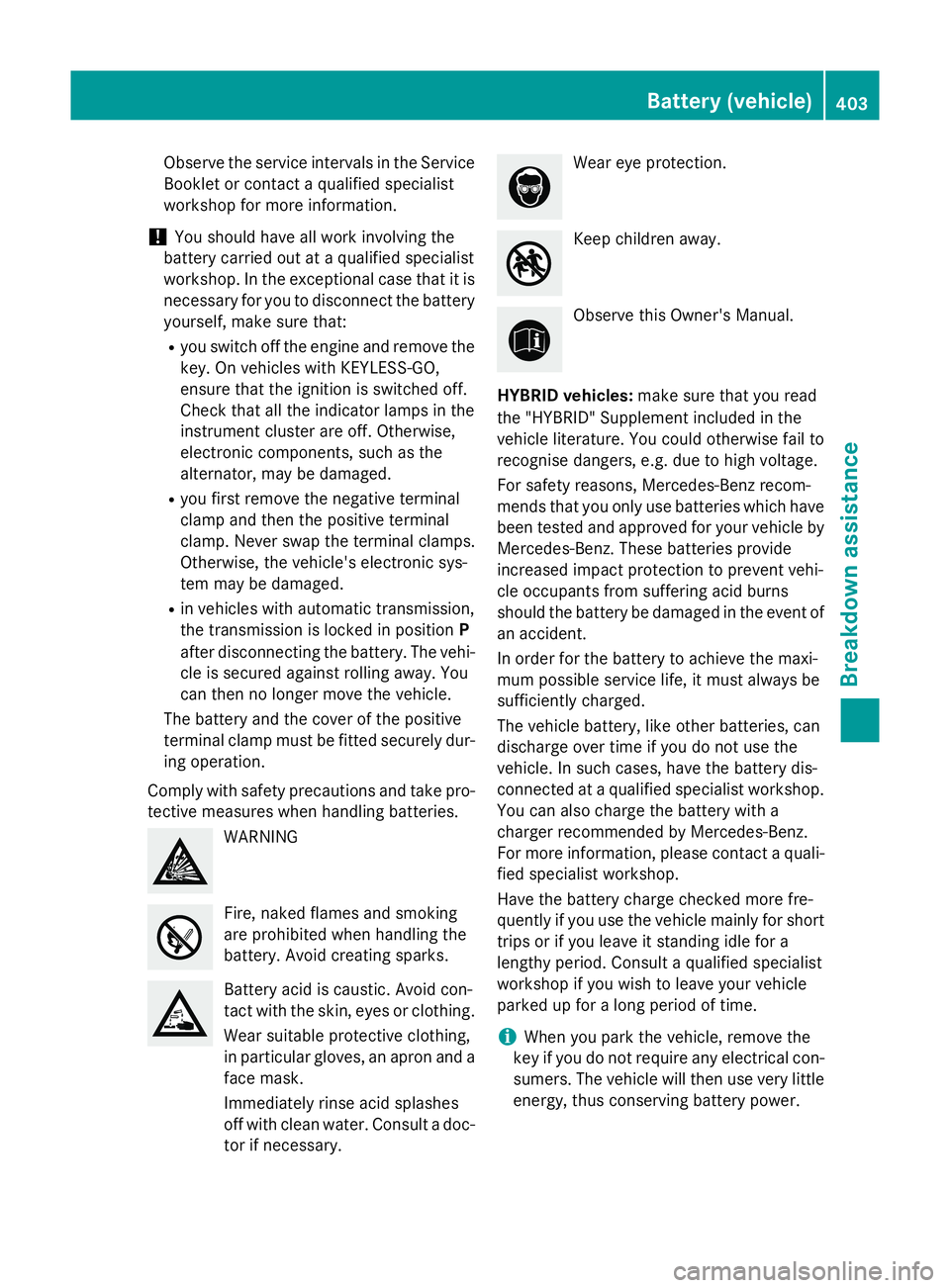
Observe the service intervals in the Service
Booklet or contact aqualified specialist
workshop for more information.
! You should have all work involving the
battery carried out at aqualified specialist
workshop. In the exceptional case that it is
necessary for you to disconnect the battery yourself, make sure that:
R you switch off the engine and remove the
key. On vehicles with KEYLESS-GO,
ensure that the ignition is switched off.
Check that all the indicator lamps in the
instrument cluster are off. Otherwise,
electronic components, such as the
alternator, may be damaged.
R you first remove the negative terminal
clamp and then the positive terminal
clamp. Never swap the terminal clamps.
Otherwise, the vehicle's electronic sys-
tem may be damaged.
R in vehicles with automatic transmission,
the transmission is locked in position P
after disconnecting the battery. The vehi-
cle is secured against rolling away. You
can then no longer move the vehicle.
The battery and the cover of the positive
terminal clamp must be fitted securely dur- ing operation.
Comply with safety precautions and take pro-
tective measures when handling batteries. WARNING
Fire, naked flames and smoking
are prohibited when handling the
battery. Avoid creating sparks.
Battery acid is caustic. Avoid con-
tact with the skin, eyes or clothing.
Wear suitablep rotective clothing,
in particularg loves, an apron and a
face mask.
Immediately rinse acid splashes
off with clean water. Consult adoc-
tor if necessary. Wear eye protection.
Keep children away.
Observe this Owner's Manual.
HYBRID vehicles: make sure that you read
the "HYBRID" Supplement included in the
vehicle literature. You could otherwise fail to
recognise dangers, e.g. due to high voltage.
For safety reasons, Mercedes-Benz recom-
mends that you only use batteries which have been tested and approved for your vehicle by
Mercedes-Benz.T hese batteries provide
increased impact protection to prevent vehi-
cle occupants from suffering acid burns
should the battery be damagedint he event of
an accident.
In order for the battery to achieve the maxi-
mum possibles ervice life, it must always be
sufficiently charged.
The vehicle battery, like other batteries, can
discharge over time if you do not use the
vehicle. In such cases, have the battery dis-
connected at aqualified specialist workshop.
You can also charge the battery with a
charger recommended by Mercedes-Benz.
For more information, pleasec ontactaquali-
fied specialist workshop.
Have the battery charge checked more fre-
quently if you use the vehicle mainly for short
trips or if you leave it standing idle for a
lengthy period. Consult aqualified specialist
workshop if you wish to leave your vehicle
parked up for along period of time.
i When you park the vehicle, remove the
key if you do not require any electrical con-
sumers. The vehicle will then use very little energy, thus conserving battery power. Battery (vehicle)
403Breakdown assistance Z
Page 409 of 497
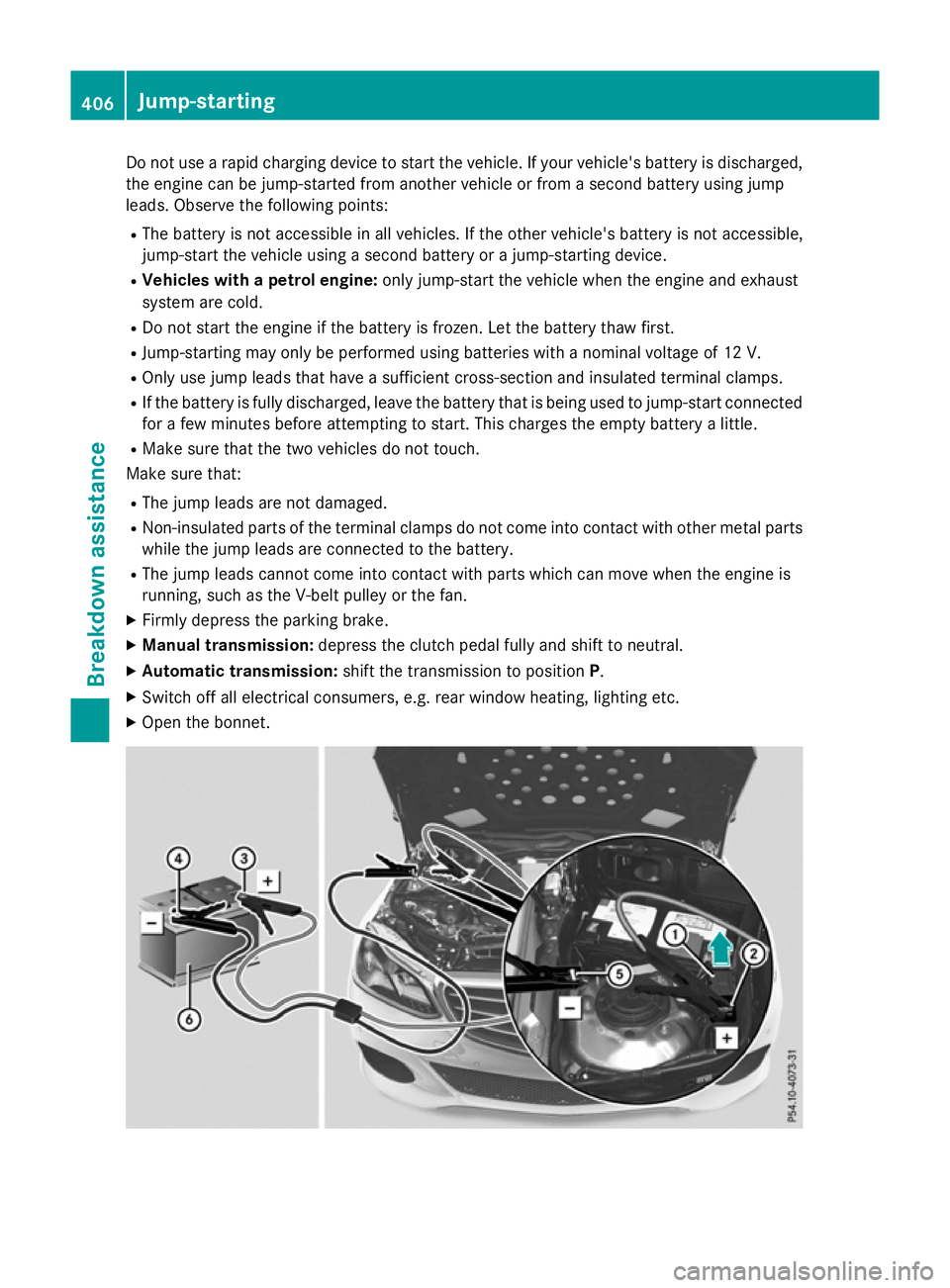
Do not us
earapid charging device to start the vehicle. If your vehicle' sbattery is discharged,
the engine can be jump-started fro manothe rvehicl eorf romas econd battery using jump
leads. Observe the following points:
R Th eb attery is not accessibl einallvehicles .Ifthe other vehicle' sbattery is not accessible,
jump-star tthe vehicl eusing asecond battery or ajump-starting device.
R Vehicle swithap etrolengine: onlyjump-star tthe vehicl ewhent he engine and exhaust
syste marecold.
R Do not start the engine if the battery is frozen. Let the battery tha wfirst.
R Jump-starting ma yonlybep erforme dusing batteries with anominal voltag eof12V.
R Onl yusejum pleads thathaveas ufficient cross-sectio nand insulate dtermina lclamps.
R If the battery is full ydischarged, leav ethe battery tha tisb eing used to jump-star tconnected
for afew minute sbefor ea ttempting to start. This charge sthe empty battery alittle.
R Make sure tha tthe two vehicles do not touch.
Make sure that:
R Th ej um pleads aren ot damaged.
R Non-insulate dparts of the termina lclamps do not come into contact with other meta lparts
whil ethe jum pleads arec onnected to the battery.
R Th ej um pleads cannot come into contact with parts which can mov ewhent he engine is
running ,suc hast he V-bel tpulle yort he fan.
X Firml ydepress the parking brake.
X Manual transmission: depress the clutch peda lfully and shift to neutral.
X Automatic transmission: shift the transmission to position P.
X Switch off al lelectrica lconsumers ,e.g.r ea rw indo wh eating, lighting etc.
X Open the bonnet. 406
Jump-startingBreakdow
nassistance
Page 413 of 497
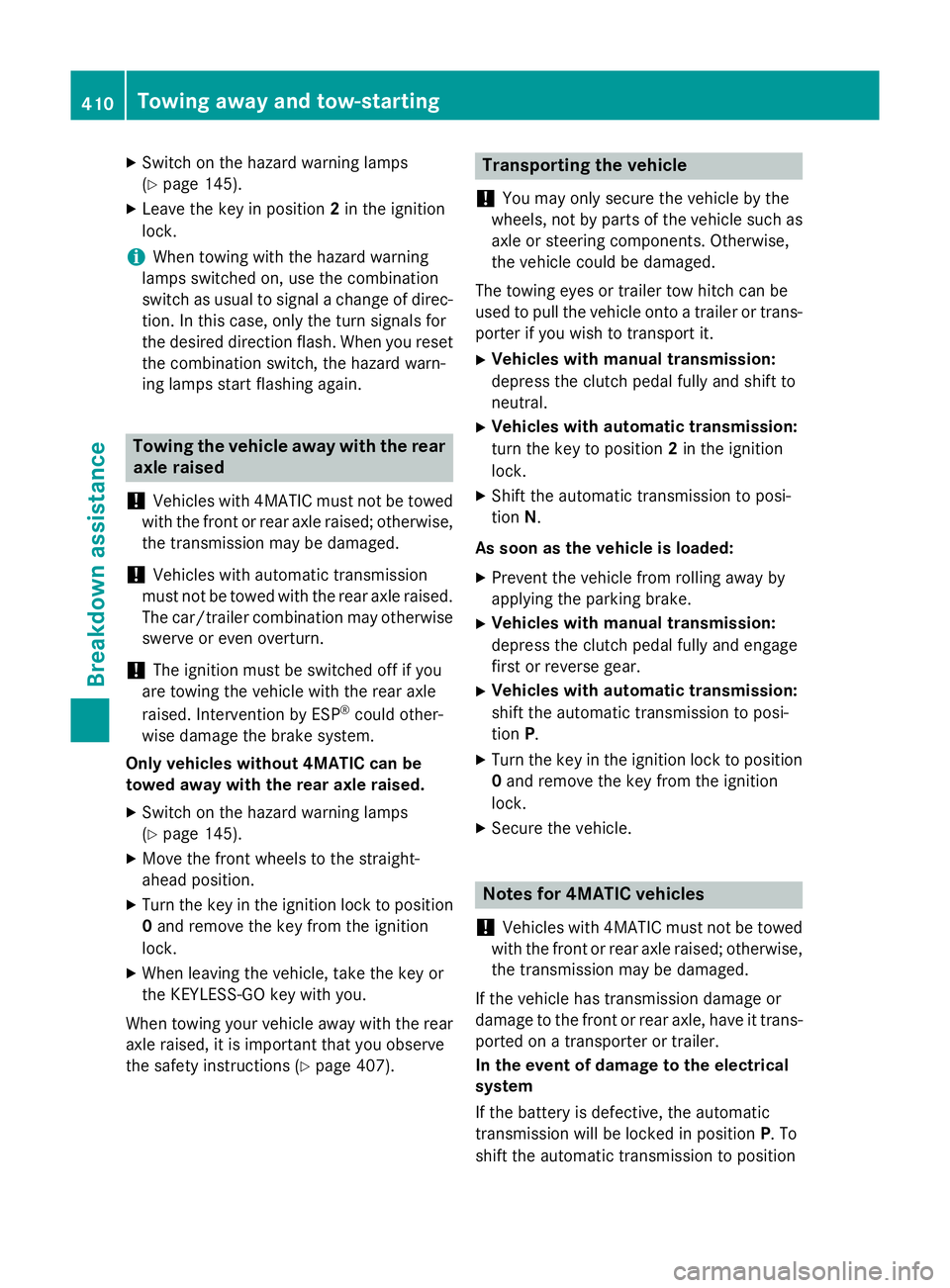
X
Switch on the hazard warning lamps
(Y page 145).
X Leave the key in position 2in the ignition
lock.
i Whe
ntowing with the hazard warning
lamps switche don, us ethe combination
switch as usua ltosignal achange of direc-
tion. In this case, onl ythe turn signal sfor
the desired direction flash. Whe nyou reset
the combination switch, the hazard warn-
ing lamps star tflashing again. Towin
gthe vehicle awa ywitht he rear
axl eraised
! Vehicles with 4MATI
Cmustn ot be towed
with the front or rea raxler aised ;otherwise,
the transmissio nmay be damaged.
! Vehicles with automatic transmission
mus tnot be towed with the rea raxler aised.
The car/traile rcombination may otherwise
swerve or eve noverturn.
! The ignition mus
tbes witche doff if you
are towing the vehicl ewitht he rea raxle
raised .Intervention by ESP ®
could other-
wise damag ethe brake system.
Onl yvehicle swithout 4MATIC can be
towed awa ywitht he rear axl eraised.
X Switch on the hazard warning lamps
(Y page 145).
X Mov ethe front wheel stothe straight-
ahea dposition.
X Turn the key in the ignition lock to position
0 and remove the key from the ignition
lock.
X Whe nleaving the vehicle, take the key or
the KEYLESS-GO key with you.
Whe ntowing your vehicl eawayw itht he rear
axl eraised ,itisi mportant tha tyou observe
the safety instructions (Y page 407). Transporting the vehicle
! Yo
um ay onl ysecure the vehicl ebythe
wheels, not by parts of the vehicl esuchas
axl eors teering components .Otherwise,
the vehicl ecould be damaged.
The towing eyes or traile rtow hitch can be
used to pull the vehicl eonto atraile rort rans-
porter if yo uwishtot ranspor tit.
X Vehicles with manual transmission:
depress the clutch peda lfully and shift to
neutral.
X Vehicles with automatic transmission:
turn the key to position 2in the ignition
lock.
X Shift the automatic transmissio ntoposi-
tion N.
As soon as the vehicle is loaded: X Prevent the vehicl efrom rolling away by
applying the parking brake.
X Vehicles with manual transmission:
depress the clutch peda lfully and engage
first or reverse gear.
X Vehicles with automatic transmission:
shift the automatic transmissio ntoposi-
tion P.
X Turn the key in the ignition lock to position
0 and remove the key from the ignition
lock.
X Secure the vehicle. Note
sfor 4MATIC vehicles
! Vehicles with 4MATI
Cmustn ot be towed
with the front or rea raxler aised ;otherwise,
the transmissio nmay be damaged.
If the vehicl ehastransmissio ndamageor
damag etothe front or rea raxle, have it trans-
ported on atransporter or trailer.
In the even tofdamage to the electrical
system
If the battery is defective, the automatic
transmissio nwillbel ocked in position P.To
shift the automatic transmissio ntoposition 410
Towin
gawayand tow-startingBreakdown assistance
Page 487 of 497
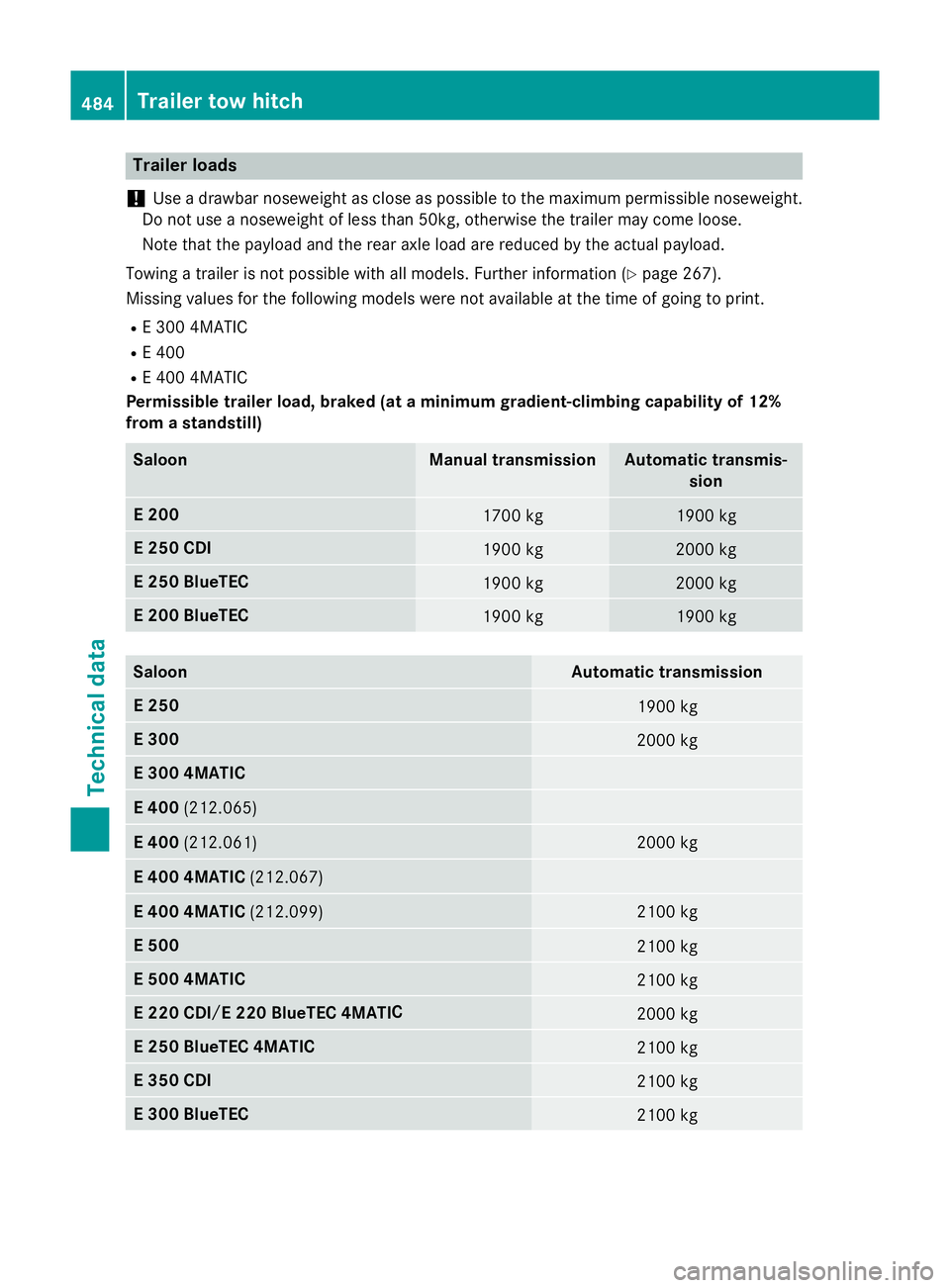
Trailer loads
! Use
adrawbar noseweight as close as possibl etothe maximum permissibl enoseweight.
Do not us eanoseweight of less tha n50kg, otherwis ethe trailer ma ycome loose.
Note tha tthe payloa dand the rea raxlel oa da rereduce dbythe actual payload.
Towing atrailer is not possibl ewitha llmodels. Further informatio n(Ypage 267).
Missing values for the following model sweren ot availabl eatthe time of going to print.
R E3 00 4MATIC
R E4 00
R E4 00 4MATIC
Permissibl etrailer load, braked (at aminimum gradient-climbing capability of 12%
fro mas tandstill) Saloon Manual transmission Automati
ctransmis-
sion E2
00 1700 kg 1900 kg
E2
50 CDI 1900 kg 2000 kg
E2
50 BlueTEC 1900 kg 2000 kg
E2
00 BlueTEC 1900 kg 1900 kg
Saloon Automati
ctransmission E2
50 1900 kg
E3
00 2000 kg
E3
00 4MATIC E4
00 (212.065) E4
00 (212.061) 2000 kg
E4
00 4MATIC (212.067) E4
00 4MATIC (212.099) 2100 kg
E5
00 2100 kg
E5
00 4MATIC 2100 kg
E2
20 CDI 2000 kg
E2
50 BlueTEC 4MATIC 2100 kg
E3
50 CDI 2100 kg
E3
00 BlueTEC 2100 kg484
Trailer tow hitchTechnica
ldata E2
20 BlueTEC 4MATI C
/
Page 488 of 497

Saloon Automatic transmission
E3
50 BlueTEC 2100 kg
E3
50 BlueTEC 4MATIC 2100 kg
Permissible trailer load, braked (at
aminimum gradient-climbing capability of 12%
from astandstill) Estate Manual transmission Automatic transmis-
sion E2
00 1700 kg 2100 kg
E2
50 CDI 1900 kg 2100 kg
E2
50 BlueTEC 1900 kg 2100 kg
E2
00 BlueTEC 1900 kg 2100 kg
E2
20 BlueTEC 1900 kg 2100 kg
Estate Automatic transmission
E2
50 2100 kg
E4
00 (212.265) 2100 kg
E4
00 (212.261) 1700 kg
E4
00 4MATIC (212.267) E4
00 4MATIC (212.299) 1700 kg
E5
00 2100 kg
E5
00 4MATIC 2100 kg
E2
50 BlueTEC 4MATIC 2100 kg
E3
00 BlueTEC 2100 kg
E3
50 BlueTEC 2100 kg
E3
50 BlueTEC 4MATIC 2100 kg
Permissible trailer load, unbraked
Saloon Manual transmission Automatic transmis-
sion E2
00 750 kg 750 kg
E2
50 CDI 750 kg 750 kgTrailer tow hitch
485Technical data ZE2
20 BlueTEC 4MATI C/
Page 489 of 497
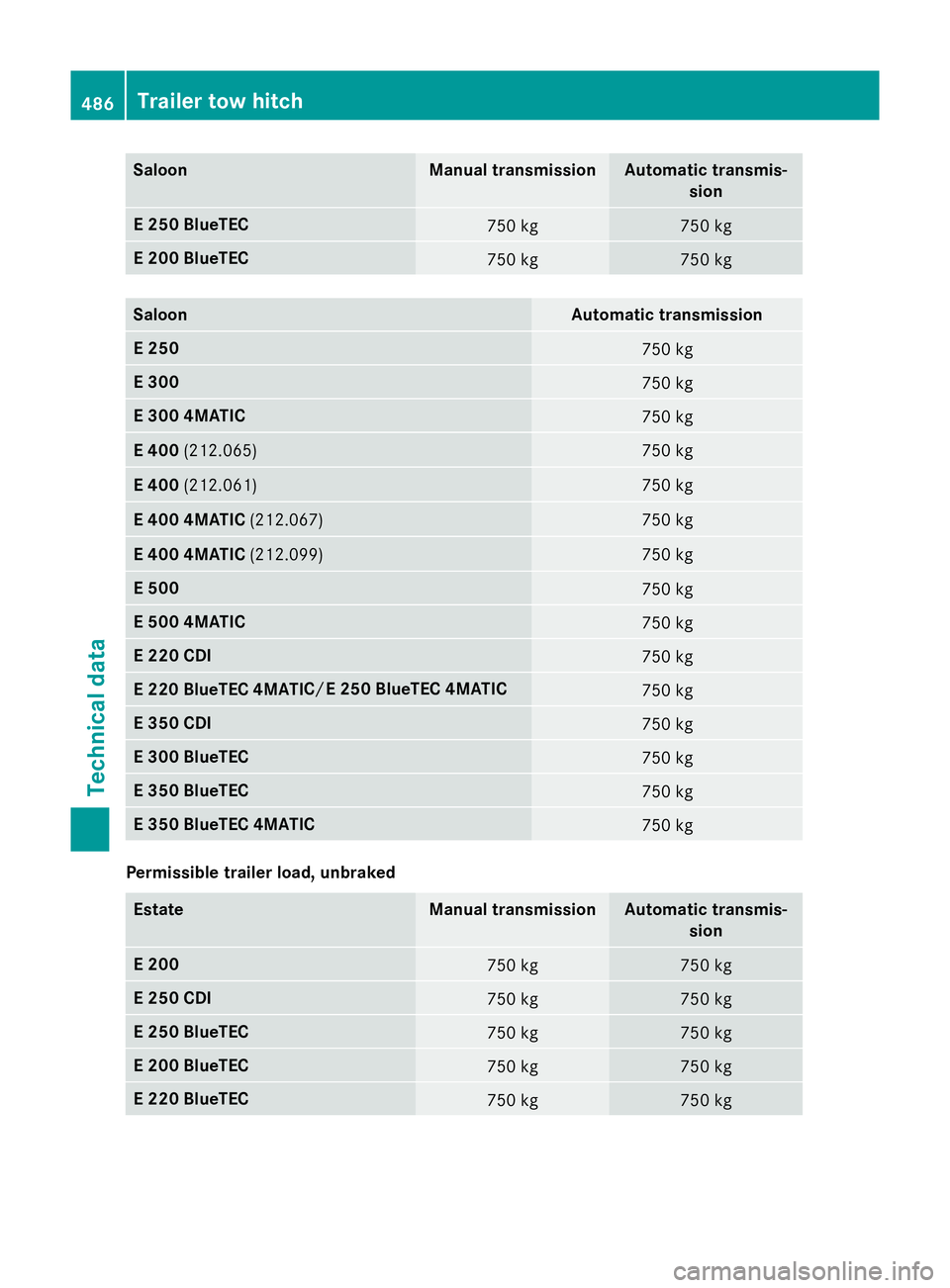
Saloon Manual transmission Automatic transmis-
sion E2
50 BlueTEC 750 kg 750 kg
E2
00 BlueTEC 750 kg 750 kg
Saloon Automatic transmission
E2
50 750 kg
E3
00 750 kg
E3
00 4MATIC 750 kg
E4
00 (212.065) 750 kg
E4
00 (212.061) 750 kg
E4
00 4MATIC (212.067) 750 kg
E4
00 4MATIC (212.099) 750 kg
E5
00 750 kg
E5
00 4MATIC 750 kg
E2
20 CDI 750 kg
750 kg
E3
50 CDI 750 kg
E3
00 BlueTEC 750 kg
E3
50 BlueTEC 750 kg
E3
50 BlueTEC 4MATIC 750 kg
Permissible trailer load, unbraked
Estate Manual transmission Automatic transmis-
sion E2
00 750 kg 750 kg
E2
50 CDI 750 kg 750 kg
E2
50 BlueTEC 750 kg 750 kg
E2
00 BlueTEC 750 kg 750 kg
E2
20 BlueTEC 750 kg 750 kg486
Trailer tow hitchTechnical data E2
50 BlueTEC 4MATIC
E2 20 BlueTEC 4MATI C/
Page 491 of 497
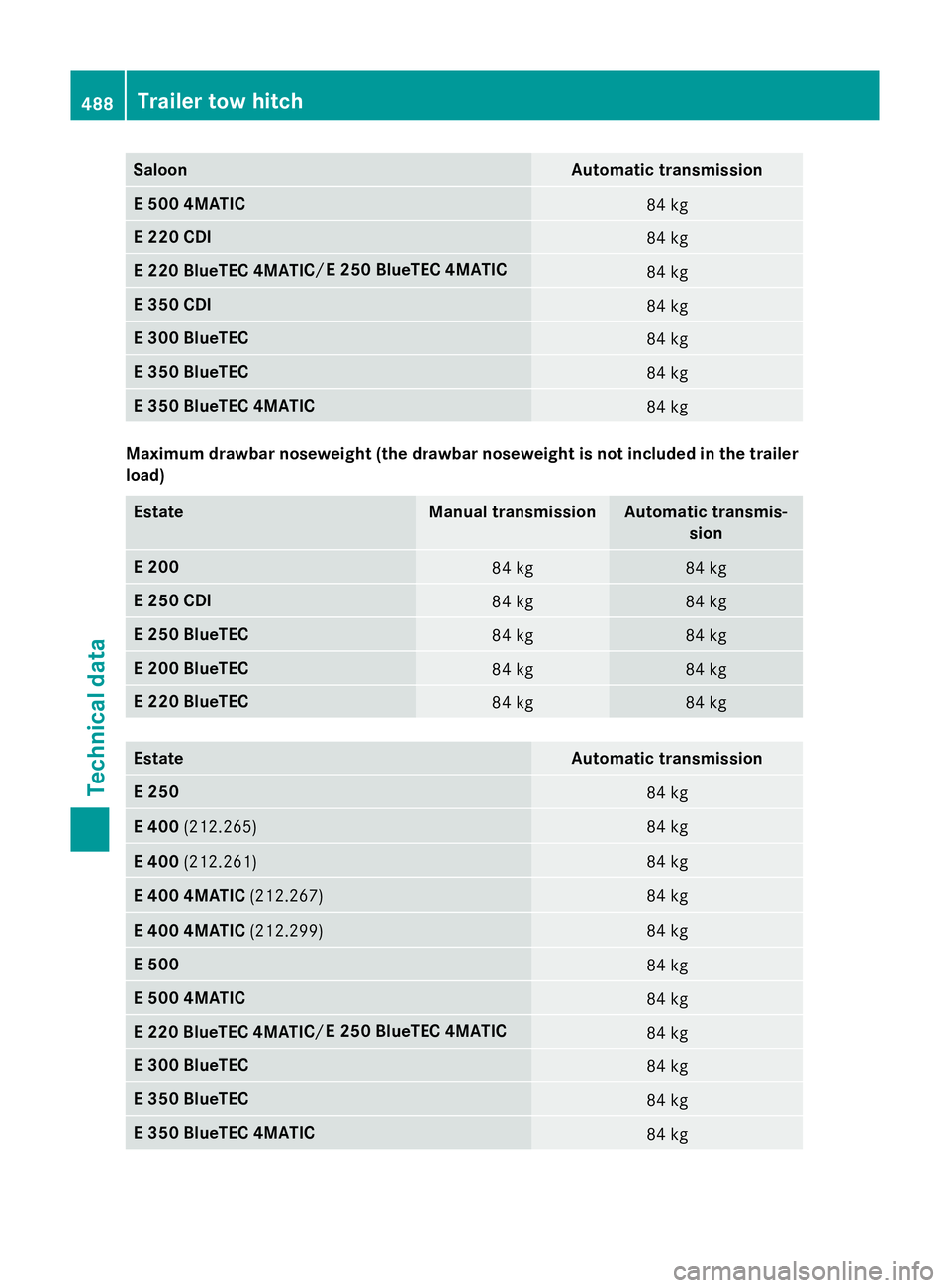
Saloon Automatic transmission
E5
00 4MATIC 84 kg
E2
20 CDI 84 kg
84 kg
E3
50 CDI 84 kg
E3
00 BlueTEC 84 kg
E3
50 BlueTEC 84 kg
E3
50 BlueTEC 4MATIC 84 kg
Maximumd
rawbar noseweight (the drawbar noseweight is not included in the trailer
load) Estate Manual transmission Automatic transmis-
sion E2
00 84 kg 84 kg
E2
50 CDI 84 kg 84 kg
E2
50 BlueTEC 84 kg 84 kg
E2
00 BlueTEC 84 kg 84 kg
E2
20 BlueTEC 84 kg 84 kg
Estate Automatic transmission
E2
50 84 kg
E4
00 (212.265) 84 kg
E4
00 (212.261) 84 kg
E4
00 4MATIC (212.267) 84 kg
E4
00 4MATIC (212.299) 84 kg
E5
00 84 kg
E5
00 4MATIC 84 kg
84 kg
E3
00 BlueTEC 84 kg
E3
50 BlueTEC 84 kg
E3
50 BlueTEC 4MATIC 84 kg488
Trailer tow hitchTechnical data E2
50 BlueTEC 4MATIC
E2 20 BlueTEC 4MATI C/
E2 50 BlueTEC 4MATIC
E2 20 BlueTEC 4MATI C/
Page 493 of 497
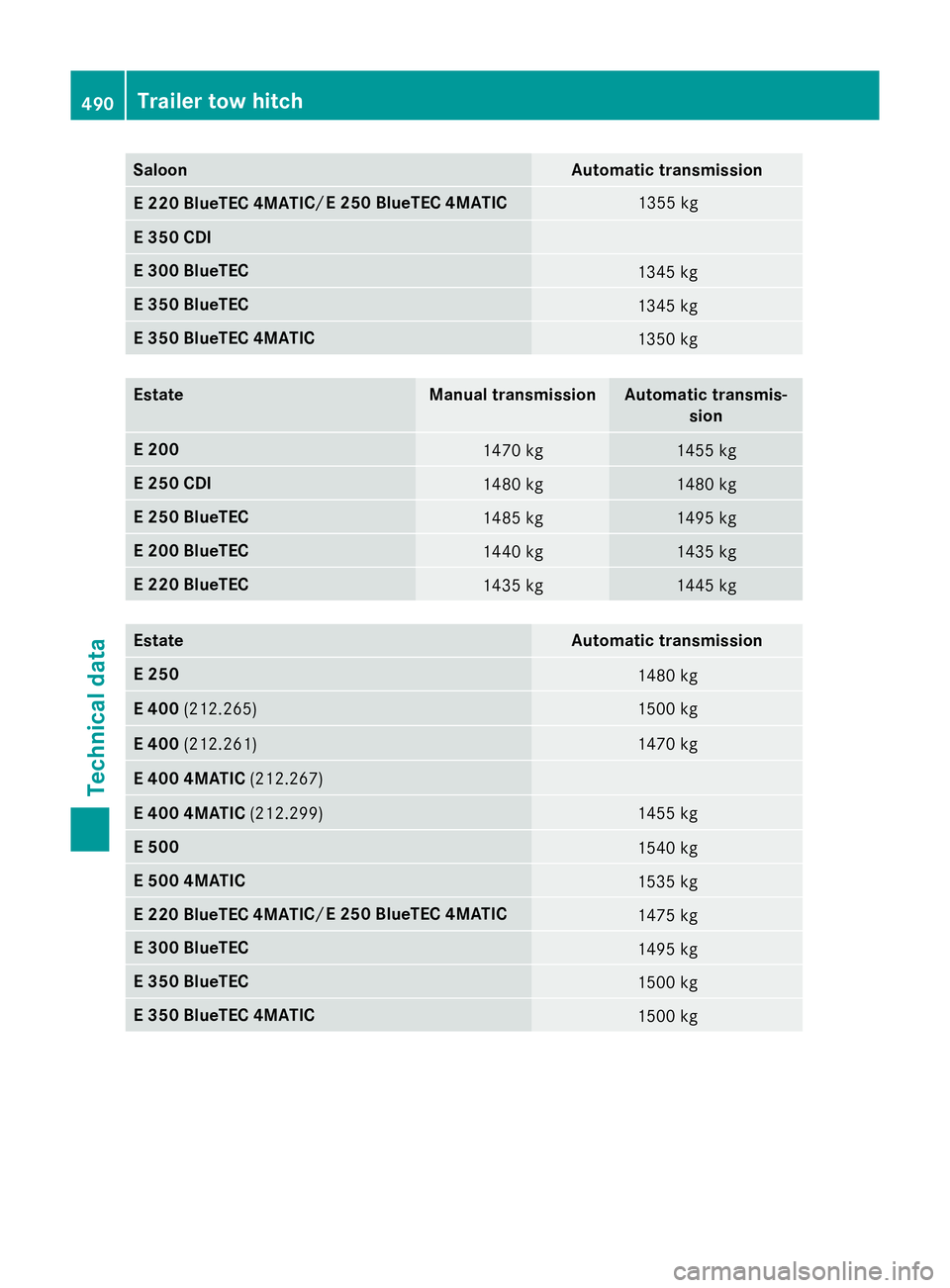
Saloon Automatic transmission
E3
50 CDI E3
00 BlueTEC 1345 kg
E3
50 BlueTEC 1345 kg
E3
50 BlueTEC 4MATIC 1350 kg
Estate Manual transmission Automatic transmis-
sion E2
00 1470 kg 1455 kg
E2
50 CDI 1480 kg 1480 kg
E2
50 BlueTEC 1485 kg 1495 kg
E2
00 BlueTEC 1440 kg 1435 kg
E2
20 BlueTEC 1435 kg 1445 kg
Estate Automatic transmission
E2
50 1480 kg
E4
00 (212.265) 1500 kg
E4
00 (212.261) 1470 kg
E4
00 4MATIC (212.267) E4
00 4MATIC (212.299) 1455 kg
E5
00 1540 kg
E5
00 4MATIC 1535 kg
1475 kg
E3
00 BlueTEC 1495 kg
E3
50 BlueTEC 1500 kg
E3
50 BlueTEC 4MATIC 1500 kg490
Trailer tow hitchTechnical data E2
50 BlueTEC 4MATIC
E2 20 BlueTEC 4MATI C/
1355 kg
E2 50 BlueTEC 4MATIC
E2 20 BlueTEC 4MATI C/